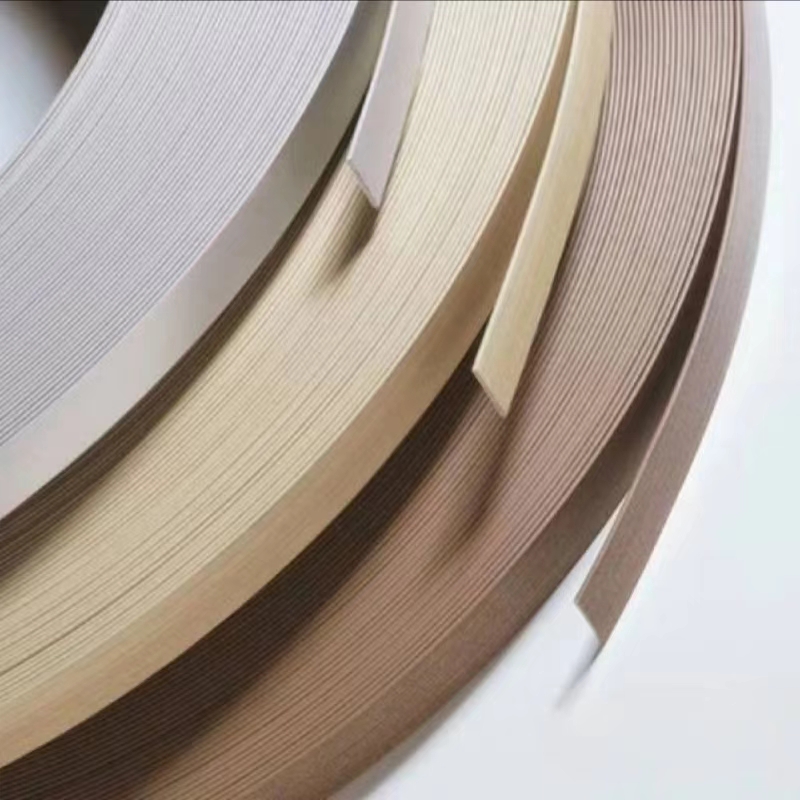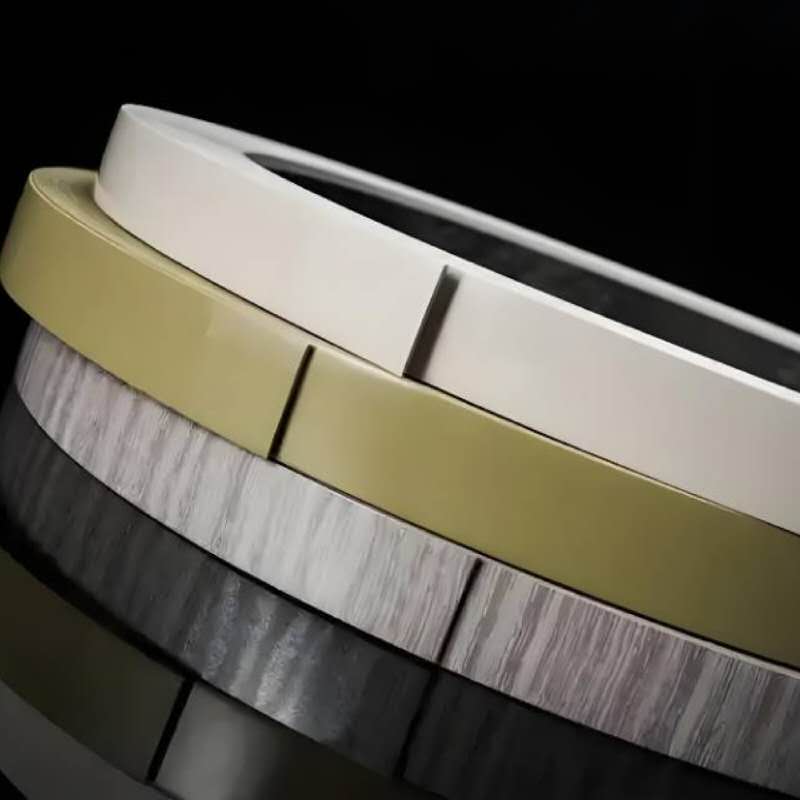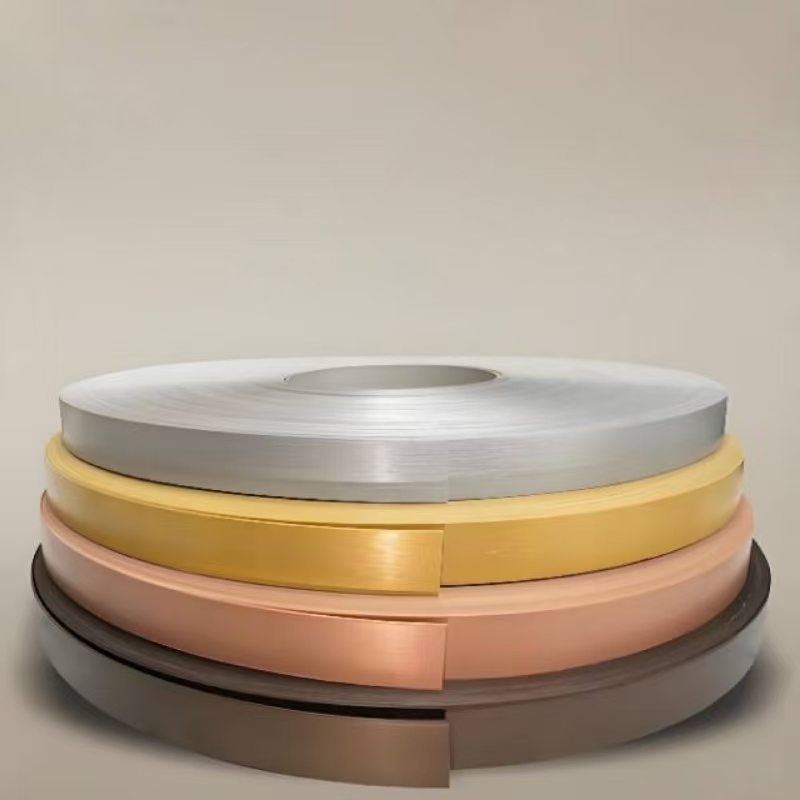Edge banding, as an indispensable component of modern home decoration, is mainly used to protect the edges of furniture from damage, enhance the aesthetics, and extend the service life of furniture. As consumers' requirements for furniture quality and design increase, the types of edge banding materials are becoming more and more abundant. The two most common edge banding materials are PVC edge banding and ABS edge banding.
This article will explore the advantages and disadvantages of these two materials, their applicable scenarios, and the differences between them to help consumers choose the most suitable edge banding material.

What is edge banding?
Edge banding refers to the material used for edge sealing of furniture panels, usually for edge treatment of materials such as medium-density fiberboard (MDF), particleboard, and solid wood boards. Its function is to protect the edge of the panel from wear and collision, and it also has the functions of beauty, durability, and easy cleaning. Edge banding can be made of different materials, colors, and textures to match the overall design style of the furniture.
The installation of edge banding is usually fixed to the edge of the panel by hot melt adhesive, pressing, etc. Edge banding is not only widely used in the home field, but also in office furniture, kitchen furniture, wardrobes and other places.
What is the best material for edge banding?
PVC edge banding
As one of the most common edge banding materials, PVC (polyvinyl chloride) edge banding is widely used in various furniture due to its excellent performance and applicability. PVC is a polymer plastic with good chemical resistance, water resistance, wear resistance and processability, making it an ideal material for edge banding.
What are the advantages of PVC edge banding?
Advantages of PVC edge banding:
1. Affordable
2. Good waterproofness
3. Strong customizability
4. Good processing performance

1. Affordable
PVC edge banding has a low production cost, so the price is more affordable, especially for furniture manufacturers who have certain cost restrictions. Its price advantage makes PVC edge banding dominate the mass market.
2. Good waterproof performance
PVC material itself has good waterproof performance, so PVC edge banding can effectively prevent moisture from eroding furniture panels and extend the service life of furniture. This feature makes PVC edge banding perform particularly well in humid environments such as kitchens and bathrooms.
3. Strong customizability
PVC edge banding can be made into different colors, patterns and sizes as needed during the production process to meet the needs of different furniture styles. Whether it is simple style or European style, PVC edge banding can provide corresponding color options.
4. Good processing performance
PVC edge banding has good processing performance and can be produced through hot melt, extrusion and other processes. During the processing, PVC material is more stable, not easy to deform, and the operation is simple and easy.
What are the disadvantages of PVC edge banding?
Disadvantages of PVC edge banding:
1. Susceptible to temperature
2. Easy to age
1. Susceptible to temperature
Although PVC material has certain temperature resistance, it is easy to deform in high temperature environment, especially when exposed to sunlight for a long time. Compared with other materials, PVC edge banding has slightly inferior heat resistance.
2. Easy to age
PVC materials have a serious aging problem. After long-term use, the surface of the edge banding may fade, yellow, etc., affecting the appearance of the furniture. In addition, the aged PVC material tends to become brittle, causing cracks or falling off of the edge banding.
3. Environmental issues
Although PVC itself does not contain harmful substances, during the production and waste treatment process, PVC materials may release toxic gases and pollute the environment. Therefore, PVC edge banding is less environmentally friendly, and in some markets with strict environmental requirements, PVC materials may face certain restrictions.

ABS edge banding
ABS (acrylonitrile-butadiene-styrene copolymer) edge banding, as a high-performance material, has gradually attracted market attention in recent years. ABS materials have high strength, toughness and heat resistance, so they have been widely used in some furniture products with high performance requirements.
What are the advantages of ABS edge banding?
Advantages of ABS edge banding:
1. Strong heat resistance
2. Excellent impact resistance
3. Good durability
4. Higher environmental protection
1. Strong heat resistance
Compared with PVC edge banding, ABS edge banding has better stability in high temperature environment. It can withstand higher temperatures, especially in direct sunlight or heating environment, the deformation degree of ABS edge banding is much smaller. Its strong heat resistance makes ABS edge banding more widely used in some special environments.
2. Excellent impact resistance
ABS material has high impact resistance, so ABS edge banding can effectively resist external force collision and avoid edge banding cracking or falling off due to external impact. This feature makes ABS edge banding suitable for high-traffic and frequently used furniture, such as office tables and chairs, kitchen counters, etc.
3. Good durability
ABS edge banding has strong durability and is not prone to fading, cracking and other problems after long-term use. In addition, ABS materials have strong UV resistance, which can effectively prevent aging caused by UV rays and maintain the color and appearance of the edge banding.
4. Higher environmental protection
Compared with PVC materials, ABS materials have better environmental protection performance. ABS edge banding does not release harmful substances during the production process and can be recycled and reused after use. Therefore, in some environmentally friendly markets, ABS edge banding is becoming more and more popular.
What are the disadvantages of ABS edge banding?
Disadvantages of ABS edge banding:
1. Higher cost
2. Difficult to process
3. Sensitive to moisture
1. Higher cost
Due to the high price of ABS materials themselves, the cost of producing ABS edge banding is also relatively high. Therefore, the market price of ABS edge banding is higher than that of PVC edge banding, which limits its application range to a certain extent.
2. Difficult to process
The processing of ABS materials is relatively complicated and requires more sophisticated equipment and technical support. Especially in hot melt, molding and other processes, the operation of ABS materials is difficult and may require more time and process adjustments.
3. Sensitive to moisture
Although ABS edge banding has good waterproof performance, it is slightly inferior to PVC edge banding in humid environments. ABS edge banding may be deformed or loosened to a certain extent after long-term exposure to a humid environment.

Comparison between PVC edge banding and ABS edge banding
When choosing edge banding materials, PVC edge banding and ABS edge banding each have their own advantages and disadvantages, and consumers should choose according to actual needs. Here is a comprehensive comparison of the two materials:
| Features | PVC edge banding | ABS edge banding |
| Cost | Low | Higher |
| Heat resistance | Poor, easy to deform | Excellent, high temperature resistance |
| Impact resistance | General | Excellent |
| Durability | Easy to age and fade | Good, not easy to fade, UV resistance |
| Environmental protection | Relatively poor, may pollute the environment during production and disposal | More environmentally friendly, no harmful substances are released during the production process |
| Application range | Widely used in cost-sensitive markets | Suitable for markets with high durability and performance requirements |
Where Can I Buy Wholesale ABS Edge Banding at Factory Prices?
If you are looking for wholesale ABS edge banding with factory-direct prices, Tingjie is your best choice. As a professional manufacturer and supplier in China, we specialize in producing customized edge banding solutions for the furniture and cabinetry industries. Our high-quality ABS edge banding is available in a variety of colors, sizes, and finishes, making it ideal for commercial and residential furniture applications. With a production capacity of 10,000 tons per year, we ensure a steady supply to customers in Europe, North America, the Middle East, and Asia. Get a competitive quote today and take advantage of our latest sales and promotions!




